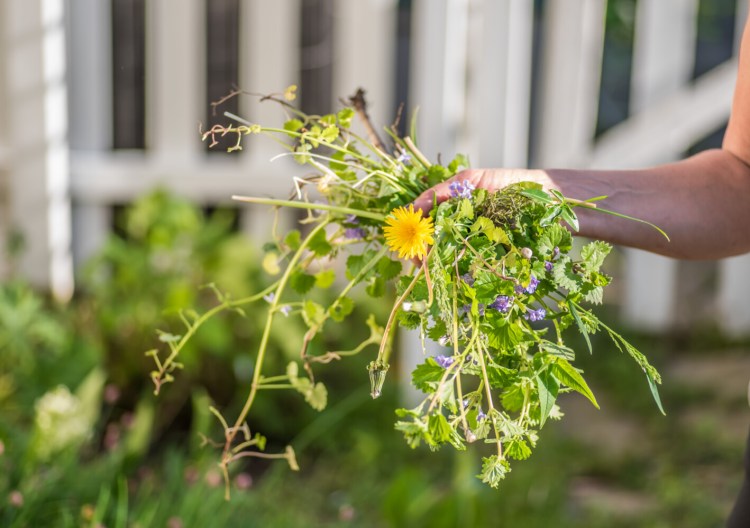Plentiful rain – at least until mid-July – and Maine’s warmest-ever July have made this a bountiful year for both flowers and vegetables.
It has also been a banner year for weeds.
While picking raspberries and vegetables, cutting dahlias and gladioli and doing any other yard chores, I spend as much time removing weeds as harvesting the crop. I’ve been trained well after almost half a century of marriage. If I see a weed, I pull it out.
Weeds are bad for several reasons.
Most importantly, we want our yard to be attractive, even if it doesn’t achieve absolute beauty during every season. Although many of their flowers are attractive by themselves (what toddler hasn’t created a bouquet of dandelions at some point?), weeds detract from that beauty.
But weeds that flower may then produce seeds, and guess what that means? Even more weeds the following year.
Weeds also harm the plants you are trying to grow – by shading them out, strangling them or stealing nutrition.
On our property, weeding is not a mentally taxing job. For the most part, I know where the plants that we intend to grow are and what they look like at every stage of their growth – I pull out anything that we didn’t put in. I say mostly because I planted seeds for a new Green Twister Echinacea this year, placing them in a vacant area at the end of a row of dahlias. While weeding the dahlias, I took out the Echinacea seedlings before recognizing them. Oh, well.
Being able to recognize weeds really helps if you let some desirable plants self-seed in the garden. That’s when it gets tougher to know which tiny seedlings you want and which you don’t.
The state of Maine offers some help, with the weeds page of its Got Pests site. It shows 26 of the most common weeds in Maine, with links to instructions for dealing with each.
In our yard, two types of chickweed, purslane, plantain, thistle, crabgrass, witch grass (which the state calls quack grass) and the always evil Asiatic bittersweet have been loving this warm, wet summer.
Some weeds, such as chickweed, sowthistle (which we have quite a lot of but I couldn’t name before I checked the Got Pests website) and jewelweed (which is not on the state’s weed list but is on its invasive species list) are shallow-rooted and easy to pull out.
Others like witch grass, dandelion and Canada thistle have deeper roots and need to be dug out with a trowel. (Keep in mind, purslane and dandelion are edible, so once you pull them, you can get in the kitchen and make a meal of it.)
My wife, Nancy, and I try (emphasize try) to go through our gardens every two or three weeks. That way we get weeds before they get large. When I pull out a tiny two-leaved sprout and see the tell-tale orange root of bittersweet, I give myself a little cheer. I got the evil vine when it was young.
Some of the plants that we consider weeds are, in other circumstances, highly desirable. We have a lot of oaks on our property. And while oaks are among the most beneficial plants in Maine for native wildlife, if we let every sprouted acorn grow into an oak tree our property would turn into an oak grove. We pull out a lot of oak and maple seedlings to protect the plants we really want to grow.
If the weeds have gotten away from you, try a fall renovation.
Remove any plants you want to save and place them in pots or in what I call a rescue bed. Dig up the soil six or seven inches deep, add some compost or other organic matter to enrich it. Rake the soil every two weeks to defeat the weeds. (This information comes from Cornell, via the state’s weed website.)
Replant your rescued plants and any new additions in the spring.
Many gardeners have tried using a heavy black fabric weed barrier, thinking it will be what its name says it is. Once they put the fabric down, they cover it with mulch.
It doesn’t work. Aggressive weed seeds (think thistle and bittersweet) sprout in the mulch, put their roots through the fabric and are harder than ever to pull out. And when you want to add plants, you have to cut the fabric in addition to digging a hole, twice the work. Plus, cutting that hole in the fabric means you’ve given the weed seeds in the soil an opening. (And believe me, they’ll take it.)
So, I say, it is better, easier and less expensive to get outside and weed regularly.
Tom Atwell has been writing the Maine Gardener column since 2004. He is a freelance writer gardening in Cape Elizabeth and can be contacted at 767-2297 or at:
tomatwell@me.com
Send questions/comments to the editors.



Success. Please wait for the page to reload. If the page does not reload within 5 seconds, please refresh the page.
Enter your email and password to access comments.
Hi, to comment on stories you must . This profile is in addition to your subscription and website login.
Already have a commenting profile? .
Invalid username/password.
Please check your email to confirm and complete your registration.
Only subscribers are eligible to post comments. Please subscribe or login first for digital access. Here’s why.
Use the form below to reset your password. When you've submitted your account email, we will send an email with a reset code.